There is so much to say about our life-changing voyage across the widest expanse of open ocean in the world. I hardly know where to begin. We have daily ship logs, Cindy’s voice recordings, Cindy’s attempted Facebook posts, Rick’s daily journal, photos, video, and statistics reflecting all kinds of details of the crossing like hours motoring, wind speed, distance traveled per day, etc. At some point, I will try to compile all of those sources and give you a blow by blow of the journey. But for now, just to whet your appetite, here is a little article I wrote for Latitude 38 Sailing magazine, an edited form of which appears in their July issue under the Cruising Notes section.
* * * * *
Eight years since the dream sprouted from a hot tub conversation over wine in our Northern California foothill home, my husband Rick and I cast off the docklines from Banderas Bay on March 27, 2018 to sail to the South Pacific. It still sends chills down my spine when I see on the chart plotter, the words “South Pacific Ocean.” I can’t believe we made it here.
Here are a few lessons we learned about sailing and life on this voyage.
1. Move slowly and deliberately through life. Take your time in all things.
I started out this voyage feeling like Dorothy skipping down the yellow brick road singing, “we’re off to see the wizard, the wonderful wizard of Oz!” I was so thrilled to have finally set our course to the Marquesas that nothing could stand in my way. But as Latitude 38 put it, I soon found the road to Oz had more than a few potholes. After a while, my body became battered and bruised; if I wasn’t black and blue on every inch of my body, it at least felt like I was: my hips, my shins, the backs of my elbows, and my shoulders were all sore from taking the brunt of blows all day and night long. Even my neck was sore from wrapping it around the compression post to keep me standing while pulling on my shorts in the morning. I felt like a human pinball. I thought after 3 1/2 years of full time cruising, I had become accustomed to rocking and rolling, but nothing prepared me for the constant side to side movement, sometimes quite violent, that occurred when the swell was anywhere but directly aft. It tended to get worse with speed.
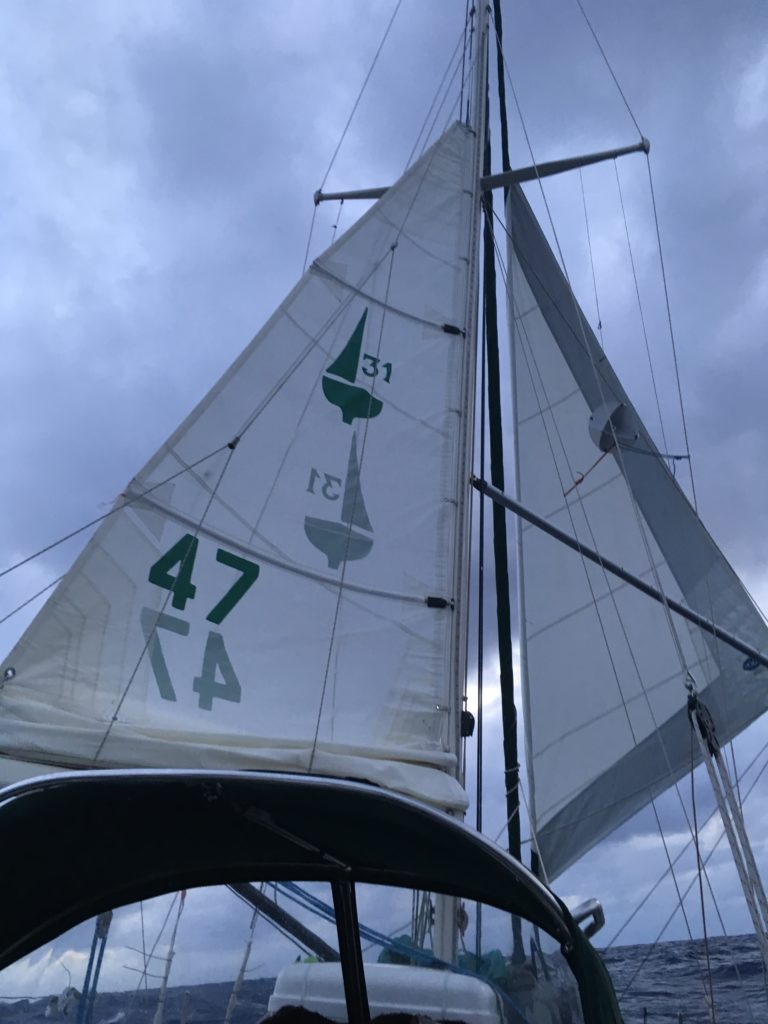
Wing on wing, a sail configuration that helps Cool Change move more quickly going downwind, also makes for a more rolly ride with seas any greater than one meter
On day 13, it all came to a head. We had 20+ knot winds and 2-3 meter seas off the port quarter. I had spent my off-watch afternoon struggling in the galley, digging out ingredients, chopping vegetables and cooking over the stove for a three day supply of fajitas. After each vegetable was chopped, I had to lay down and take a break to regain my strength because I was sweating all over from the intense body control required to stand in one place with a knife in my hand and not chop a finger off or drop the knife on my foot. Just as I finished and was ready to relax, Rick caught a Dorado, which he wanted to eat immediately.
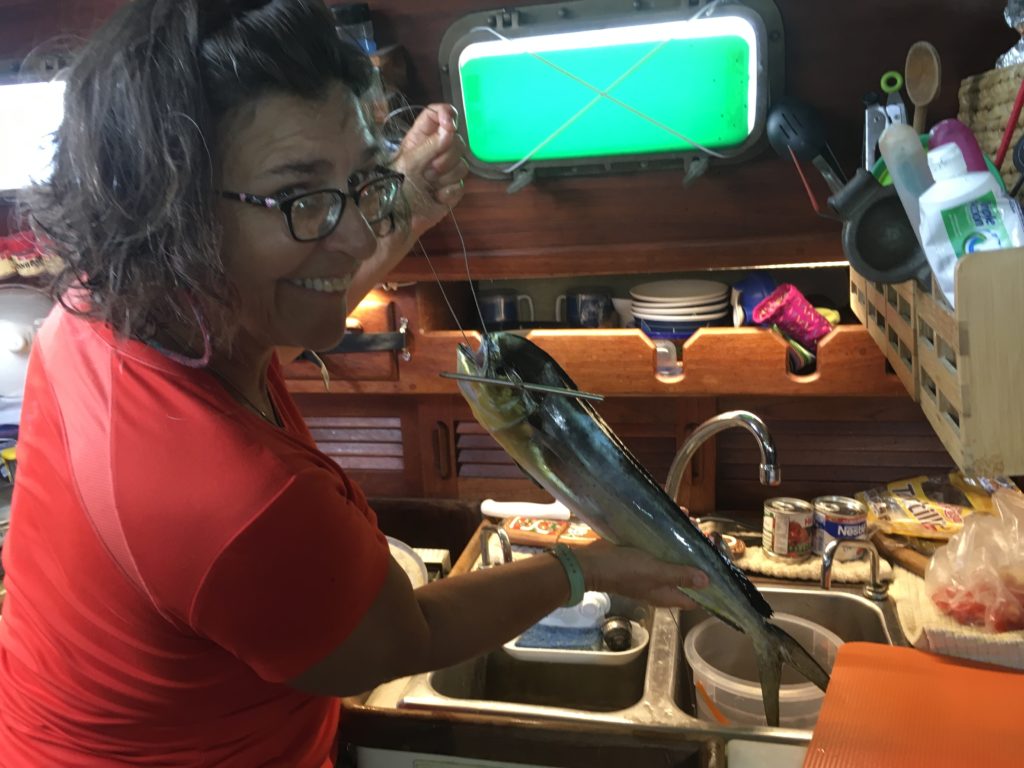
One of the two dorados that Rick caught during the crossing. Normally we would toss a small one like this back in, but with no freezer, he was just the right size to eat.
I prepared sashimi out of Rick’s dorado. I set the wasabi and a small lidded bowl of soy sauce at the top of the companionway. As I climbed the companionway stairs with the plate of sashimi in hand, a wave slammed us from starboard and I fell back down the companionway and I was thrown into the galley. As I started back up the companionway stairs for a second time, a wave hit us with equal force from port and I was thrown down the companionway stairs again and into the propped-open head door, which broke in two lengthwise from the force of my body. After picking up the pieces of the broken door, I mustered the will to try once again and finally made it to the top of the stairs. Throughout it all, the plate of sashimi somehow survived, but after a few bites, Rick decided he wanted it cooked in tacos instead. So he went down to the galley and cooked up the fish. I suggested he add a little chipotle mayonnaise we had left in the fridge. After we finished the fish, we had some fajitas, mostly I guess because I felt they deserved to be eaten after I had worked so hard on them. But within two hours after eating, I became violently ill from both ends: food poisoning. I thought it was the fish, Rick thinks it was the chipotle mayo, but since we were unsure and the fajitas looked so unappetizing after that, I threw the whole batch overboard. That was a really, really bad day.
That day prompted the realization that my romantic honeymoon with the sea was over. I needed to face the realities of this ocean crossing. My biggest concern was how to move around the boat comfortably. I decided I would move very very slowly and deliberately at all times, constantly being mindful of the boat’s movement in tune with the sea, and relinquish any attempt whatsoever to impose my will over the wishes of the sea. I stopped hurrying. Like mountain climbing, I made sure each foothold and handhold was secure before making the next step. It worked. During the second half of the voyage, my bruises started healing, my broken finger nails started growing again, and hot dinners didn’t get made unless the sea permitted it. I figure this is also a good lesson to prepare for getting old; there will come a time, I have witnessed, that moving around even on land can become dangerous to fragile old bones; I will take this lesson into my old age with me.
2. Do something nice for someone in distress if the opportunity presents itself… It will really lift your spirits.
Only a day or two after I had my epiphany about the realities of ocean crossings, a skipper in our fleet came on the SSB net to say that he had lost his steering and had been floundering for days while trying to get it working again. As a result, they had lost time in the crossing and were down to only 5 liters of drinking water for three crew members to last at least 10 days before landfall. He asked if anyone was in the vicinity could give them some water. We are a small boat with minimal tankage but we do have a water maker and we were only 30 miles from him. We couldn’t in good conscience not help. So we planned a rendezvous point and a water exchange method, and managed to get him enough water to last either until a rain catchment system could be devised or another boat could come by. We also attached a little goodie bag including candies and even some rum for the captain!
The operation was not without risk, since their steering was unreliable, the rolling seas could entwine our masts if we got as close as needed to toss a line with an attached water jug back and forth, and there was always the danger that a line from a missed toss could get caught in the propellor. On the 2013 Baja Haha, we crewed for a boat that required a fuel exchange to make it to Cabo, so Rick and I both had experience in our respective roles of tossing the lines and driving the boat. That experience helped, and a good dose of luck was with us. The stakes involved, the look of overwhelming appreciation on the faces of the crew of the distressed boat, the excitement of anticipation, the pride in ourselves and our little boat of pulling it off, and the satisfaction of having come to the aid of a boat in distress pulled me completely out of my funk and was worth all the danger the effort entailed.
3. Dinnertime is very special. Honor and respect it with good food and a dedicated allotment of time.
This is as true in an ocean crossing as it was back in my father-knows-best childhood home. Every night, Rick and I sat down together in the cockpit and shared a good meal. Sometimes he prepared the meal and sometimes I did. It was the one time a day we could actually devote to being together. Even though we were obviously together on the same small boat, off-watches tended to be spent down below while the person on watch remained in the cockpit. We planned it so that we ate before the evening radio net. We asked each other about our days, and took the time to work through any brewing disagreements before they got out of hand. It was our “time out” after a long night and day of surviving on this extended wilderness trip.
And the food was good; no instant noodles allowed! We had ten pre-prepared frozen meals of lasagna, chile and stew ready to heat up and eat, and after those were gone, we had enough food to last months, including pizza from scratch, curry with pork and coconut milk, spring rolls, enchiladas, several one-pot chicken dishes, spaghetti with sauce and canned ground beef, the list goes on and on. Following the abundance of good information on how to store vegetables and fruit without refrigeration, we had fresh veggies throughout the trip. In fact, we arrived in the Marquesas with two heads of cabbage, several onions, potatoes and jicama, and even a few tomatoes and green peppers still in tact. Once the fresh fruit was gone, dried or dehydrated fruits took their place. Canned meats of all types are still plentiful in our lockers.
I baked our own bread and made yogurt every other day or so. But we also had food for when the going got too rough to cook; one of our favorite meals turned out to be Trader Joe’s canned dolmas with a Greek salad of tomatoes, cheese, and kalamata olives in a balsamic vinegrette. And having food to spare when we arrived in the Marquesas was a blessing; it is so liberating to know that you are not tethered to a location with a store in order to have a good meal, especially when a can of tomatoes here costs $4 US!
5. The ocean is as varied as it is vast.
Somehow I had acquired the mistaken impression that in the absence of land, I would experience nothing but a monotonous view of ocean and sunny blue sky in increasing heat for 3,000 miles. How wrong was I! We found ourselves breaking the trip down into segments, and each segment had a different weather pattern. The first, just getting past the Socorro’s, was cloudy with choppy waves and good wind. Then we got into some light wind days on our way to the NE tradewinds, where the sea was calm on the sky was clear. When we hit the NE tradewinds, the winds and accompanying seas obviously picked up dramatically, and I found it kind of cold, especially at night. I actually put my foulies on one night.
Heading south into the ITCZ was our biggest surprise. Everyone in our fleet was anticipating the ITCZ with foreboding; it loomed ahead of us like the harbinger of death and destruction. Stories abounded of towering rain clouds, lightening all around and high winds that came out of nowhere and changed direction to cause accidental jibes. On the contrary, we loved the ITCZ. The air finally didn’t feel cold to me at night any more; it was so soft it was soothing. Yes, the clouds were dramatic, and we were grateful that the lightening remained off at a distance, but the most we saw was 30 knot winds and they only shifted at most by about 45 degrees. (In fact, one day I remarked to Rick how weird it was that the wind direction had just taken a dramatic shift in a matter of seconds, and he said, “Look behind you.” I did, and there was a massive dark cloud approaching that brought rain and wind within 5 minutes). Meanwhile, the seas were otherwise calm, and we had enough wind to sail all but about 12 hours. The squalls made life exciting, but they were over fairly quickly and gave our boat a good bathing. The rain was warm and refreshing. We crossed the equator in pleasant light winds, just right for making our offerings to Neptune and having a little dress-up party. And then we hit the SE trades – OMG. Talk about a freight train! And unlike the NE trades, we hit the SE trades on a beam reach, which made them all the more awe-inspiring. Like most everyone else in our little fleet, we roared to the finish line with reefed sails and holding on tight.

What a squall looks like: darkened skies ahead, puffy towering clouds over a menacing bottom, and usually sheets of rain obscuring the horizon
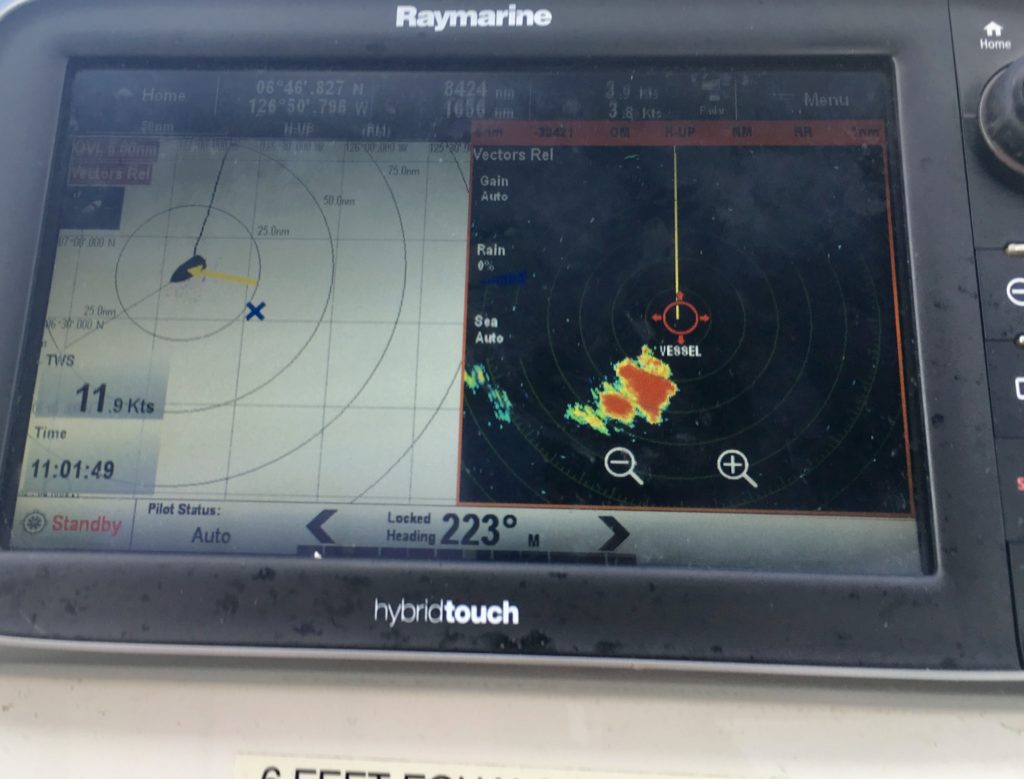
What a squall looks like on radar. This one was behind us but moving in our direction faster than we were moving. RADAR was an awesome aid to navigating squalls, by helping us to identify how large they were, how fast they were moving and in what direction. Occasionally we were able to avoid them or outrun them, but more likely, we were just better prepared for them due to RADAR.
6. Good preparation not only pays off in fewer breakdowns, it also reduces mental stress.
Except for my incident with the head door and a cockpit mike that was on its last legs before we started the trip, nothing at all broke on the entire voyage. Rick had spent many sleepless nights before we left Mexico, dreaming up yet another unlikely scenario that could cause us problems on the voyage, and addressing it as best he could in the following days. Cool Change was as prepared as any boat twice her size, and in many cases, better prepared. We had an AIS transceiver and good radar and SSB and Delorme InReach and Iridium Go! and a Monitor Windvane and additional solar panels and a new wind generator and a replaced steering cable and a replaced throttle cable and a new preventer system and a new autopilot plus a refurbished backup and an inspected and tuned rig … Cool Change was ready.
And on those nights when we were braced in the corner of the cockpit holding on from both sides as Cool Change surfed the tradewind swells and sailed, fully reefed, above hull speed, we were grateful for that rig inspection and tuning, and it put our minds more at ease. And when we helped the larger boat in distress, we were grateful that we were the ones with AIS transponder so he could find us, we were the ones with several communication methods to reach him, and we were the ones with a working steering system and a working water maker offer what hw needed. Being out alone on a vast ocean where you only have your own boat to rely on is stressful enough; you don’t need the added stress of worrying if something is going to break.
7. Don’t assume you will remember important things. Set up obvious reminders.
This is probably something that will become increasingly important as we get older, but it is true at any age. Our particular nemesis was our hand line for fishing. One evening when it was particularly bumpy, Rick suggested we heave-to for dinner. Good idea. All but afterwards when he decided to reel in his hand line. As it got shorter, he realized it had wrapped itself around the rudder or prop when we hove-to. Somehow, remarkably, he was able to fish it out with a weighted hook. But we were not so lucky the second time it happened: we had to cut the line, and even then, the lure was still wrapped somewhere below. Just fooling with it after it was cut, pushing on the line with the boat hook, finally appeared to have freed it, but it wasn’t until we were approaching landfall and put the engine in gear that we could breathe a sigh of relief that the fishing line had dislodged from the prop. After that, we stuck a piece of blue tape to the chart plotter reminding us of the fishing line – no manuevers without first hauling in that fishing line!
8. “You can’t quit; this is the ocean!”
is what a salty old sailing instructor of ours once said to a student who said she couldn’t take it anymore and she quit. There are some times in life when quitting is not an option; an ocean crossing is one of them. Yet in our small fleet of two dozen boats or so from Banderas Bay crossing at the same time as we did, there were at least two boats whose crew decided when the going got tough that they wanted to abandon ship. Seriously? One skipper got on the radio saying his only crew member “has her bags packed and is ready to get off the boat.” The crew member got onto the radio and confessed, “first it was the ITCZ, then it was the doldrums, I just can’t take it anymore!”
What do people like this think is going to happen, that 1,000 miles from land, a helicopter is standing by at their disposal to pluck them out of the boat and fly them to safety? Of course, no other boat in the fleet was willing to take on crew like that, and both boats eventually made it to landfall with their crew still aboard. Nevertheless, in my mind, there is a reason why mutiny was considered a capital offense in the days of old. Make certain that everyone realizes before you start that this is the ocean, you can’t quit.
***************************** (end of Latitude 38 article)*************************
There weren’t a lot of photo opportunities during the crossing, but here are a few other photos capturing some of our salient moments:

We crossed the equator on a beautiful, sunny morning with calm seas and just enough wind to sail. We celebrated the occasion by dressing up as Neptune and his wife to make tribute and to honor each other’s crossings. We also had special food treats, some gift exchanges, and official Shellback certificates. And somewhere, sometime, someone will find the message in a bottle that we threw overboard at the moment of crossing.
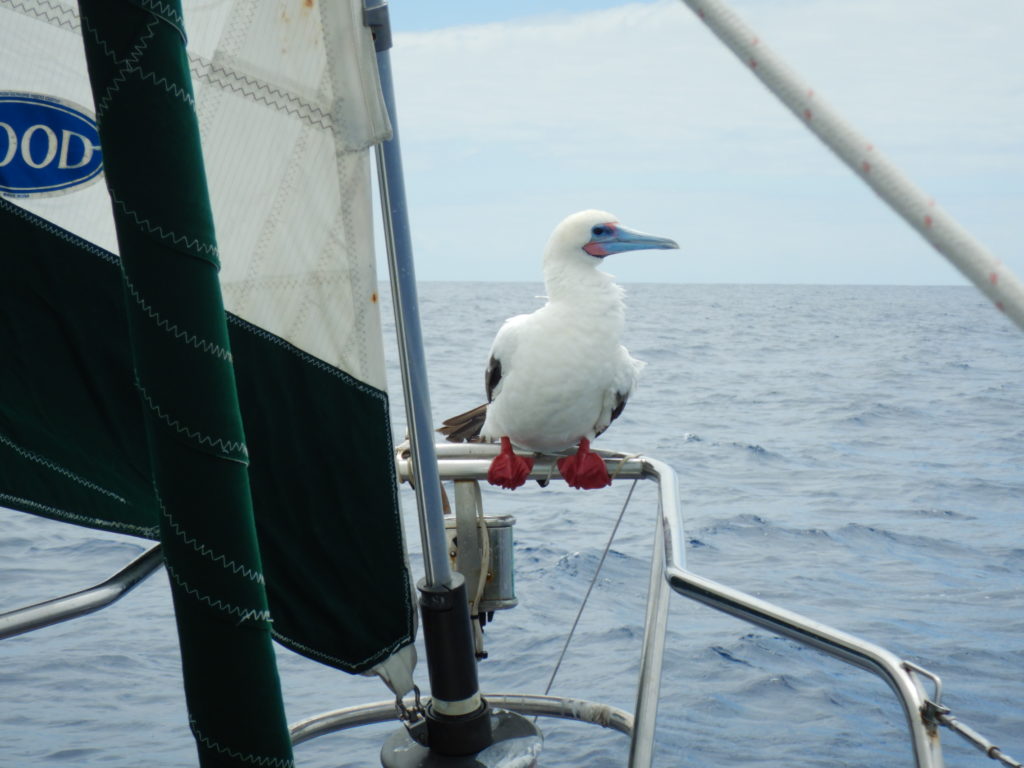
Here is our pet red-footed boobie, nicknamed Lookout, who joined us for several days during our second week of the crossing.

Many flying fish flew onto the deck every night during the first few weeks of the crossing. Unfortunately, they didn’t fly out to the sea again, and they don’t look very appetizing.

We have a cover for the cockpit but it can’t be deployed while sailing because it interferes with the boom. Nevertheless, sometimes we need sun protection for the chartplotter. So, this was our solution: an umbrella! This particular umbrella worked well because it was designed to allow wind to flow through it. We discovered, however, that it confuses Charlie, the windvane, so we can’t deploy the umbrella and Charlie at the same time.

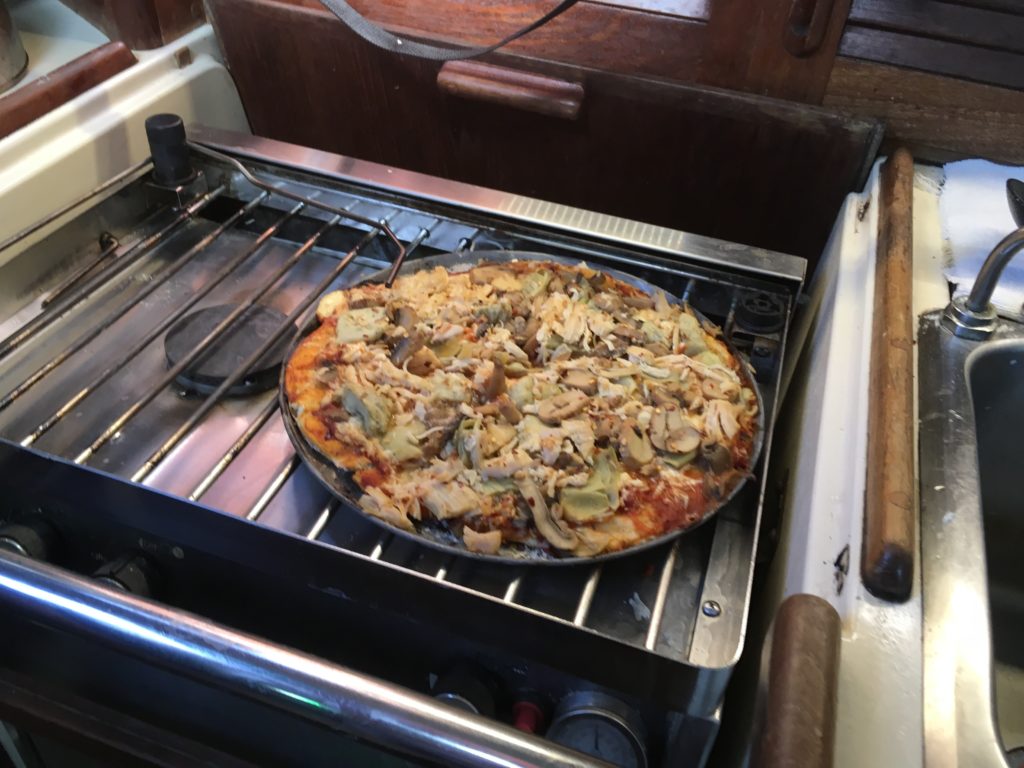
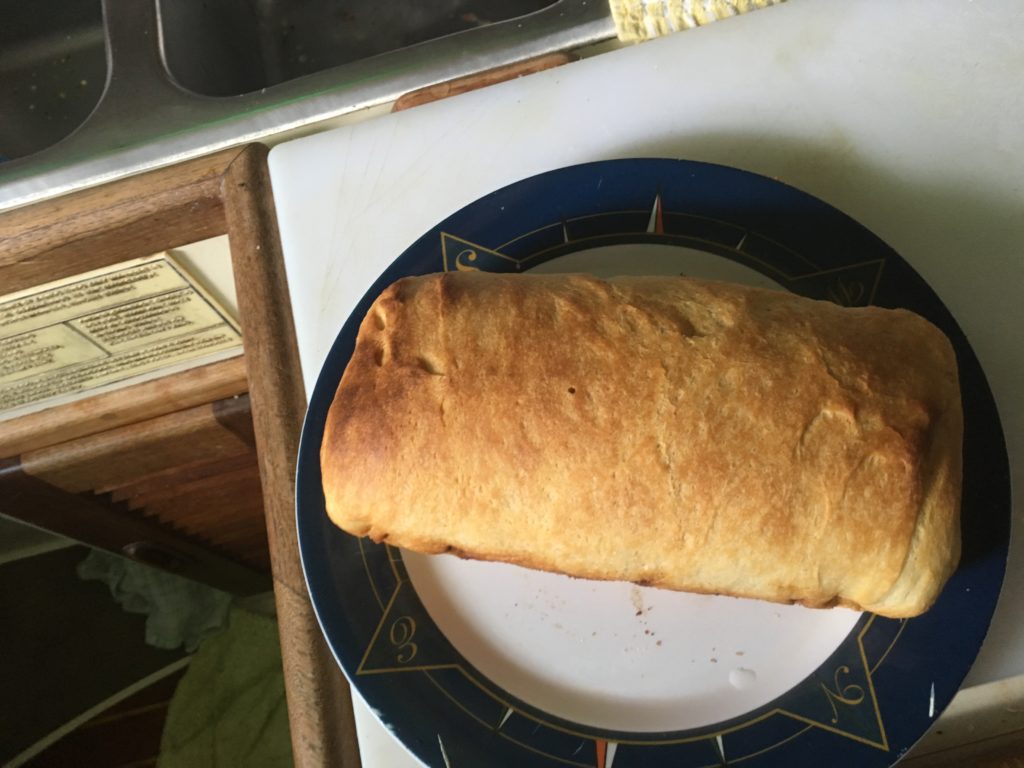
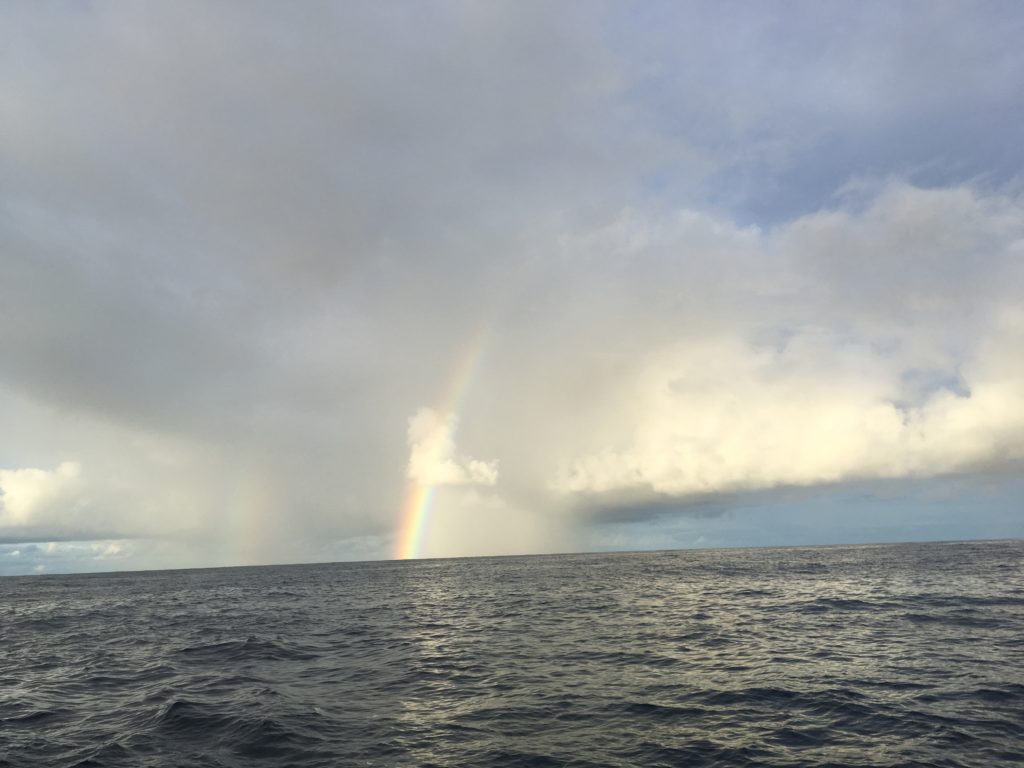

So glad you guys made landfall safe and sound. It sounded like the voyage of a lifetime! Have an awesome time.
Well done, Cool Change!
crew of Slappey ll